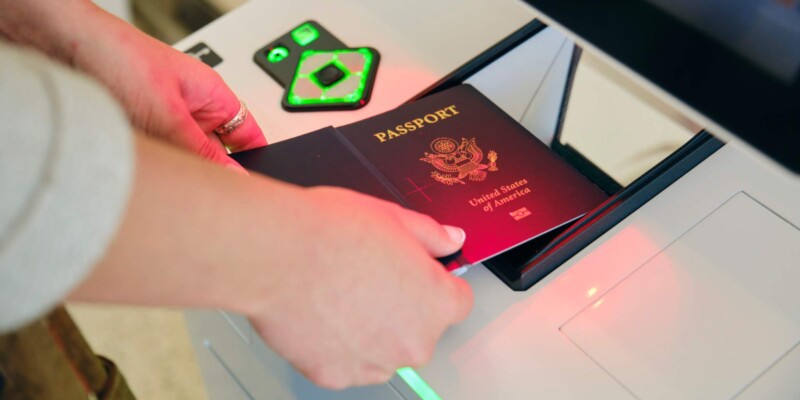How Visa-Free Travel Works and Why It Makes Trips Easier

This article provides an overview of visa-free countries based on your passport, highlights popular destinations, and offers practical tips for a smooth trip.

Find the Best International Travel Insurance
- Get multiple quotes and coverage options
- Travel Medical, Trip Cancellation & more options available
- Find the best plan for your needs and budget
What Does Visa-Free Travel Mean?
Visa-free travel means you can enter a country for a limited time without getting a visa in advance. It’s different from a visa on arrival, which you obtain at the border, or an eVisa, which requires online pre-approval before you travel.
However, depending on who you ask, all three of these types of ‘easy visa access’ fall under the visa-free category. Visa-free travel usually depends on bilateral agreements between countries and their diplomatic relationships.

That said, a country’s entry rules can change suddenly due to politics, security, or health issues. For example, after Russia’s invasion of Ukraine in 2022, several EU countries restricted visa-free access for Russian citizens.
Similarly, during the COVID-19 pandemic, many European nations temporarily suspended visa-free travel or entry from countries with high infection rates.
These examples show why it’s important to check the latest rules on an official government website before booking any travel plans.
Read More: Travel Insurance for Visa Applications
The Benefits of Visa-Free Travel
Visa-free travel offers more than just less paperwork – it opens doors for work, leisure, and personal connections across borders.
Here are some of the key ways visa-free travel can be beneficial:
Save Time and Money
The most direct win is sidestepping the entire embassy process and its many costs. You avoid the steep application fee (up to $180) and hidden costs. These include time off work, transport, and courier fees.
Travel with More Flexibility
You also gain incredible flexibility. Life doesn’t always unfold on a three-month planning cycle. A friend might announce a destination wedding in Mexico, or tickets for an international festival could suddenly go on sale. Visa-free access lets you act on these moments with greater ease.
Simplify Frequent and Business Travel
The agility that comes from visa-free travel is a huge benefit for frequent business travelers and expats.
For an expat, it unlocks easy trips to explore a country. For a consultant, it gives you the speed to act on new opportunities. You can fly to a client in São Paulo and add a last-minute meeting in Bogotá during the same trip.
Boost Tourism and Global Connections
On a bigger scale, easier travel transforms a country’s tourism. It helps build a reliable base of repeat visitors who support the local economy throughout the year.
Visa-Free Countries by Passport
A passport’s power depends on its bilateral agreements. More agreements mean more freedom to travel easily.
Each passport has different agreements, so entry rules vary by nationality. With that in mind, let’s look at some notable destinations US, UK, and Canadian passport holders can visit without a visa.
Visa-Free Countries for US Citizens
The United States passport is one of the strongest in the world. You can travel to 189 countries and territories without a visa, obtain a visa upon arrival, or apply for a simple online travel authorization (eTA).
Access covers most of Europe’s Schengen Area, where you can stay for up to 90 days for either tourism or business purposes.
However, if you plan to stay longer, you will need to apply for a Schengen visa. Travelers are also required to meet specific travel medical insurance requirements to obtain the visa.
Read more about the Schengen visa and Schengen visa insurance requirements to make sure you’re covered before your trip.

Starting in 2026, US citizens will also need to obtain an ETIAS (European Travel Information and Authorisation System) before traveling to these European countries.
A US passport allows you to visit many countries in North and South America, the Caribbean islands, and popular destinations in Asia, such as Japan and South Korea, for a quick trip.
US citizens can enter the following countries (and more) without a visa:
- Argentina – Up to 90 days
- Brazil – Up to 90 days
- Colombia – Up to 90 days
- Georgia – Up to 1 year
- Ireland – Up to 90 days (Not part of the Schengen Area)
- Israel – Up to 90 days
- Italy – Up to 90 days (Schengen Area country, will require ETIAS from 2026)
- Japan – Up to 90 days
- Malaysia – Up to 90 days
- Mexico – Up to 180 days (Requires a Forma Migratoria Múltiple/FMM upon entry)
- Morocco – Up to 90 days
- New Zealand – Up to 90 days (Requires an NZeTA online before travel)
- Panama – Up to 180 days
- Peru – Up to 183 days
- Philippines – Up to 30 days
- South Africa – Up to 90 days
- South Korea – Up to 90 days (Requires a K-ETA online before travel)
- Thailand – Up to 60 days
- Turkey – Up to 90 days
- United Kingdom – Up to 6 months (Includes England, Scotland, Wales, and Northern Ireland)
Visa-Free Countries for UK Citizens
The United Kingdom has one of the world’s most powerful passports, granting access to 191 countries without a traditional visa.
However, following Brexit, the rules for traveling to the European Union have undergone significant changes. UK citizens can now only stay in the Schengen Area for up to 90 days in any 180-day period.
Just like other countries, from 2026, UK citizens will also need to get an ETIAS online before traveling to the Schengen Area.

The list below features popular destinations, including visa-free countries and those needing simple online authorization before traveling:
- Argentina – Up to 90 days
- Australia – Up to 90 days (Requires an eVisitor visa online)
- Brazil – Up to 90 days
- Canada – Up to 6 months (Requires an eTA for air travel)
- Colombia – Up to 90 days
- France – Up to 90 days in any 180-day period (Schengen Area, will require ETIAS from 2026)
- Georgia – Up to 1 year
- Ireland – No limit (Part of the Common Travel Area)
- Japan – Up to 90 days
- Malaysia – Up to 90 days
- Mexico – Up to 180 days (Requires a Forma Migratoria Múltiple/FMM upon entry)
- Morocco – Up to 90 days
- New Zealand – Up to 6 months (Requires an NZeTA online before travel)
- Peru – Up to 183 days
- Singapore – Up to 90 days
- South Africa – Up to 90 days
- South Korea – Up to 90 days (Requires a K-ETA online before travel)
- Spain – Up to 90 days in any 180-day period (Schengen Area, will require ETIAS from 2026)
- Thailand – Up to 60 days
- United States – Up to 90 days (Requires an ESTA for air and sea travel)
Visa-Free Countries for Canadian Citizens
The Canadian passport is another powerful travel document. It opens doors to 190 countries and territories with effortless entry.
However, two significant changes are coming that will affect travel to Europe. First, while the United Kingdom remains visa-free, the new UK Electronic Travel Authorisation (ETA) will become mandatory. Second, travel to the Schengen Area in Europe will also require pre-authorization starting in 2026.
Below is a list of popular places to visit visa-free with a Canadian passport:
- Australia – Up to 90 days (Requires an eVisitor visa online)
- Brazil – Up to 90 days (Note: Visa policy can change, so always verify requirements before booking)
- Costa Rica – Up to 90 days
- France – Up to 90 days in any 180 days (Schengen Area, will require ETIAS from 2026)
- Hong Kong – Up to 90 days
- Ireland – Up to 90 days (Not part of the Schengen Area)
- Israel – Up to 90 days
- Italy – Up to 90 days in any 180 days (Schengen Area, will require ETIAS from 2026)
- Japan – Up to 90 days
- Mexico – Up to 180 days (Requires a Forma Migratoria Múltiple/FMM upon entry)
- Morocco – Up to 90 days
- New Zealand – Up to 90 days (Requires an NZeTA online before travel)
- Panama – Up to 180 days
- Peru – Up to 183 days
- Philippines – Up to 30 days
- Singapore – Up to 90 days
- South Korea – Up to 6 months (Requires a K-ETA online before travel)
- Switzerland – Up to 90 days in any 180 days (Schengen Area, will require ETIAS from 2026)
- United Kingdom – Up to 6 months (Will require an ETA for air travel starting in 2025)
- United States – Up to 6 months (ESTA not required for land entry, but recommended for air/sea travel)

Popular Visa-Free Countries Around the World
The world is a vast and fascinating place, and visa-free access can help you explore popular areas like:
Europe
The EU continent is perfect for multi-country trips. Visa-free access allows many to explore historic capitals like Paris, Rome, and Prague for up to 90 days, eliminating the need for a Schengen visa.
Beyond that, the unique cultures of the Balkans and Turkey are often just as welcoming.
Latin America
Latin America contains incredible diversity, from the ancient wonders of Peru and Mexico to the stunning natural beauty of Costa Rica and Brazil. The often generous stay allowances make it an ideal destination for travelers looking to spend more time immersing themselves in one place.

Asia
Asia is a study in contrasts, where futuristic cities sit beside ancient traditions. Visa-free arrangements for powerful passports often open up the high-tech hubs of Japan and South Korea, the bustling markets of Singapore, and the tropical landscapes of Thailand.
Africa and Oceania
For more remote adventures, easy entry makes stunning landscapes more accessible than ever. It puts the idyllic islands of Fiji and French Polynesia within reach, and opens up welcoming gateways to Africa’s wonders in places like Morocco and South Africa.
Key Things to Know Before You Travel
Visa-free access simplifies travel, but it doesn’t eliminate a country’s entry requirements. At the border, you’ll still need to meet several key conditions.
Most countries require a passport valid for at least six months after arrival. You may also need proof of onward travel.
Every country also sets a strict limit on how long you can stay, which is typically 30, 90, or 180 days.
Depending on the destination, you may also be required to follow additional rules, such as presenting proof of vaccinations, completing health declarations, or paying small local tourist fees upon arrival.
Tips for Travelers Visiting Visa-Free Countries
Traveling visa-free can make trips easier, but there are still important rules and requirements to follow. These tips will help ensure a smooth, stress-free journey.
Make Travel Insurance Your First Step
Many countries require proof of travel insurance as a condition of entry, even for visa-free travelers. Before booking, always check the latest rules on the country’s official government or embassy website.

Ensure You’re Fully Protected During Your Trip! Ensure your policy covers medical emergencies, trip cancellations, and unexpected events to avoid any problems during your trip. If your plans include high-risk activities, such as hiking, scuba diving, or skiing, make sure your policy explicitly covers adventure sports or other specialized risks.
Carry digital or paper copies of your insurance documents, along with other key travel documents such as proof of accommodation and return flights, for easy access.

We’ll Help You Choose the Right Travel Plan
Compare top-rated travel insurance plans for your upcoming trip abroad.
Check Your Destination’s Entry Rules
Always verify the latest requirements on the country’s official government or embassy website before booking.
Rules can change rapidly due to political, security, or health concerns. Check for details such as visa exemptions, entry restrictions, required documents, vaccination mandates, and local regulations to avoid delays, denied entry, or fines.
Avoid Overstaying
It’s essential to respect the maximum stay allowed. Overstaying a visa-free period can result in heavy fines, deportation, or a ban on re-entry.
Tips to stay compliant:
- Keep track of the date you entered the country.
- Set reminders a few days before your visa-free period ends.
- If you need to stay longer, check in advance whether an extension or visa is possible.
Keep Track of Entry and Exit Stamps
Always check for an entry stamp in your passport upon arrival, especially at busy airports or land borders.
When leaving, ensure you receive an exit stamp. Missing stamps can cause serious problems later, as they serve as official proof of your travel dates.

Here are some additional tips to follow:
- Take a quick photo of each stamped page as a backup.
- Keep a small travel journal or note the dates on your phone in case a stamp is missed.
- If a stamp is missing, report it to immigration officials immediately to avoid issues with future travel.
Resources to Check Visa-Free Travel Requirements
Travel rules and visa requirements vary by nationality and destination. These tools show which countries you can visit visa-free, the required documents, and any relevant health or safety regulations.
Checking them before booking helps avoid surprises and ensures a smoother trip:
- Passport Index Visa Checker – For a quick overview of visa requirements, this tool allows you to select your passport and view a color-coded list of countries you can visit visa-free.
- Sherpa Travel Requirements Map – Offers a visual, interactive way to check real-time entry rules and health requirements for each destination.
- IATA Travel Centre – The official tool airlines use at check-in to verify passport, visa, and health regulations. Ideal for precise, up-to-date information.
- VisaHQ – If you do need a visa, this service provides application forms and estimated processing times.
Keep in mind that visa rules can change at any time, so always verify requirements with the official embassy or government website before booking.
Plan Your Next Visa-Free Adventure
Visa-free travel is one of the easiest ways to explore the world. However, always check entry requirements online before your trip to avoid being turned away at the airport.
Beyond checking entry rules, good travel planning also means thinking ahead about your safety and well-being. Having the right travel insurance is a crucial part of that preparation, giving you peace of mind wherever your journey takes you.
When choosing a plan, shop around to find coverage that suits your planned activities, ensuring you’re fully protected. For example, if your trip includes activities such as hiking, scuba diving, or skiing, ensure your policy covers adventure sports, not just standard travel risks.

Find the Best International Travel Insurance
- Get multiple quotes and coverage options
- Travel Medical, Trip Cancellation & more options available
- Find the best plan for your needs and budget
Frequently Asked Questions
Do I need travel insurance for visa-free travel?
Many countries require proof of travel insurance, even for visa-free travelers. Even if it’s not mandatory, it’s highly recommended to protect against medical emergencies, trip cancellations, or unexpected events. Make sure your policy also covers any planned high-risk activities.
How can I check which countries I can visit without a visa with my passport?
Begin with a reliable online tool, such as the Passport Index Visa Checker, for a quick overview. However, because rules can change suddenly, the only source you should trust for a final answer is the official embassy or government website of the country you plan to visit.
What is the difference between visa-free travel, a visa on arrival, and an eTA?
There are three distinct types of entry. Visa-free means you only need your passport. A visa on arrival is a permit you get at the border, sometimes for a fee. An eTA (Electronic Travel Authorization) is a mandatory online pre-approval that you must obtain before traveling.
Which passport is the most powerful for visa-free travel?
Organizations like the Henley Passport Index track this, and recently, passports from Singapore, Japan, Spain, France, Germany, and Italy have been at the top, each offering access to over 190 countries without a prior visa.
Do I need a return ticket to enter a visa-free country?
Yes, you should always have one. Immigration officials see proof of an onward or return ticket as the primary evidence that you intend to leave before your stay expires. Arriving without one is a major red flag and a common reason for being denied entry.
What happens if I overstay my visa-free period?
The consequences are serious and can impact your future travel plans. You can face heavy fines, deportation at your own expense, and a ban from re-entering the country for several years, sometimes permanently. It can also create problems when applying for visas to other countries.
Read More
- The Best Travel Destinations in 2025
- The Ultimate International Travel Checklist
- A Guide to Travel Advisories, Warnings, and Alerts
- Traveling Internationally with Prescription Medication
About the Author:Richard Reynolds is a seasoned traveler who has lived in multiple countries. For over a decade, he has specialized in simplifying complex topics that global citizens face, such as visas, taxes, and asset protection, helping people unlock the possibilities of a global life.
